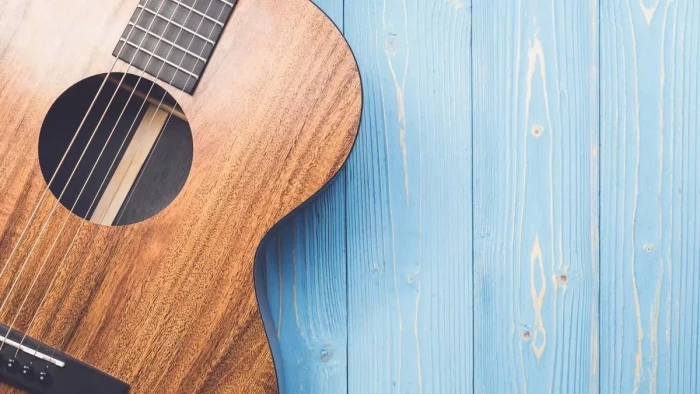What Is an Acoustic Guitar?

by:guitarnews
The guitar is equally at home in a classical concerto, a jazz improvisation, or a punk rock anthem. And while the electric guitar suits many genres, it is its older cousin—the acoustic guitar—that offers the greatest versatility.
What Is an Acoustic Guitar?
An acoustic guitar is a fretted musical instrument that produces sound via vibrating strings above a hollow chamber in the guitar’s body. The vibrations carry through the air and do not require electrical amplification (although many acoustic guitars also function as electric guitars).
How Many Strings Does an Acoustic Guitar Have?
Most acoustic guitars have six strings. The most common variation on this is a 12-string guitar, where each string is doubled with another string sounding the identical pitch, creating a rich chorus effect.
Acoustic guitar players produce sound with both their fingers and a pick. This varies depending on the genre of music, the type of guitar used, and the player’s personal preference.
What Are Nylon String Acoustic Guitars?
The original acoustic guitars were quite similar to today’s nylon string guitars. Classical guitars, Spanish guitars, and their various derivations all fit the “nylon string” category. Here are some of their key characteristics:
- 1. The guitars are made of hollow wood with a large sound hole. The species of wood used varies from guitar to guitar, but spruce is the most popular material for the top panel.
- 2. These guitars typically have wide, flat necks that allow the guitar strings to be spaced fairly far apart. Neck materials also vary, but rosewood is a popular material.
- 3. Nylon string guitars have a mellow tone with strong resonance in lower-mid frequencies.
- 4. Traditionally, the strings of these guitars were made with “catgut” (literally dried cat intestines), but nylon is the prevailing material today.
What Are Steel String Acoustic Guitars?
The category of steel string guitars is even wider than its nylon counterpart.
- 1. This category includes most of the acoustic guitars used in rock, folk, country, and bluegrass music.
- 2. The body construction is similar to a nylon string guitar, but with more frequent deviations in body shape and size. The names of these guitar shapes are, from smallest to largest: Range, Parlor, Grand Concert, Auditorium, Dreadnought, Jumbo.
- 3. Dreadnaught is the most popular shape among contemporary acoustic guitarists. Martin Guitars is particularly known for its dreadnaught models, as is Gibson. A rival brand, Taylor, has made more of a name with its grand concert and auditorium style guitars.
- 4. Spruce tops are almost the uniform standard. Some acoustics (particularly those made by the Ovation brand) feature rounded plastic backs.
- 5. Some steel guitars are made of metal, such as the resonator guitar. But these instruments, which are played with a slide, are less commonly used by beginners.
- 6. The necks tend to be narrower and more rounded than on nylon string guitars. Most necks are rosewood, although pau ferro is another popular wood.
- 7. Despite the category name, “steel string” guitars may feature strings made of nickel, aluminum, and other metals.
- 8. The metal strings give these guitars a much brighter, treble-focused sound that projects at louder volumes.
A Brief History of the Acoustic Guitar
Humans have built and played stringed instruments for millenia, and variations on the guitar trace back over 4000 years. Many musicologists trace the contemporary acoustic guitar back to the “vihuela,” a medieval instrument which itself evolved from the ancient lute. The guitar as we know it today remains quite close to a model developed by the nineteenth-century Spanish luthier Antonio Torres Jurado.
Guitar entered the realm of popular music via the blues. Early blues guitarists like Robert Johnson and Son House were among the players who brought Mississippi Delta blues music to large audiences, via their recordings. Their acoustic guitar songs inspired the great legends of classic rock, like:
- 1. The Beatles. There’s no shortage of acoustic guitar songs in the Beatles catalog. Paul McCartney’s “Blackbird” and George Harrison’s “Here Comes The Sun” are among the highlights.
- 2. Bob Dylan. Dylan was exclusively an acoustic guitarist in his early years and songs like “Blowin’ in the Wind,” “Masters of War,” and “She Belongs To Me” demonstrate his gift in composing songs on the instrument.
- 3. Led Zeppelin. Led Zeppelin guitar player Jimmy Page mined both American blues and English folk music, and the inspirations are clear on songs like “Tangerine,” “Stairway To Heaven,” and “Friends.”
- 4. Pink Floyd. The majority of Pink Floyd’s rock songs were of the “plugged in” variety, but they had acoustic peaks as well. “Wish You Were Here” is a great song based around twin acoustic guitars.
- 5. The Rolling Stones. The Stones’ ability to mix acoustic and electric guitar shines on tracks like “Salt of the Earth.”
- 6. Eric Clapton. Although most famous for his electric blues guitar, Clapton may have achieved peak popularity on his MTV Unplugged album, where he brought out acoustic versions of hits like “Layla.”
- 7. Neil Young. Many of Young’s most beloved hits are centered around his acoustic guitar strumming, such as on “Heart of Gold,” “The Needle and the Damage Done,” and “Campaigner.”
- 8. Bob Marley. Some of Marley’s most poignant compositions showcase him as an acoustic guitarist, such as “Redemption Song.”
- 9. Johnny Cash. The Man in Black never performed without an acoustic guitar in hand. From “A Boy Named Sue” to his cover of Nine Inch Nails’ “Hurt,” acoustic songs are elemental to the Cash catalog.
What Famous Bands and Artists Use Acoustic Guitars?
Plenty of other classic rockers leaned heavily on acoustic guitars. Think about these popular examples:
- 1. Kansas—“Dust in the Wind”
- 2. The Eagles—acoustic guitars are all over the classic Hotel California record
- 3. John Lennon—particularly his solo on “Working Class Hero”
- 4. The Black Crowes—“She Talks to Angels”
- 5. Contemporary acts like Ed Sheeran, Tracy Chapman, Green Day, and Radiohead have all carved out places for acoustic guitars in their work
Tips for Playing Acoustic Guitar
If you’re a beginner on the acoustic guitar, there are many resources to get your playing up to speed.
- 1. Start your acoustic guitar journey by learning guitar chords. This lets you accompany singers, including yourself. Remember it’s not just about chord shapes but also mastering strumming patterns.
- 2. Practice is equal parts technique and theory. When you practice technique, you train your fingers to do what you want them to do. When you study theory, you learn where your fingers can go and why.

